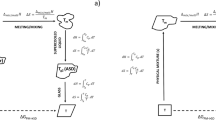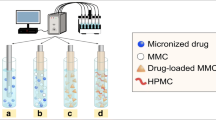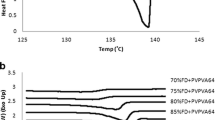ABSTRACT
Purpose
To explore the application of solution calorimetry for measuring drug solubility in experimentally challenging situations while providing additional information on the physical properties of the solute material.
Methods
A semi-adiabatic solution calorimeter was used to measure the heat of dissolution of prednisolone and chlorpropamide in aqueous solvents and of griseofulvin and ritonavir in viscous solutions containing polyvinylpyrrolidone and N-ethylpyrrolidone.
Results
Dissolution end point was clearly ascertained when heat generation stopped. The heat of solution was a linear function of dissolved mass for all drugs (<10% RSD, except for chlorpropamide). Heats of solution of 9.8 ± 0.8, 28.8 ± 0.6, 45.7 ± 1.6 and 159.8 ± 20.1 J/g were obtained for griseofulvin, ritonavir, prednisolone and chlorpropamide, respectively. Saturation was identifiable by a plateau in the heat signal and the crossing of the two linear segments corresponds to the solubility limit. The solubilities of prednisolone and chlopropamide in water by the calorimetric method were 0.23 and 0.158 mg/mL, respectively, in agreement with the shake-flask/HPLC-UV determined values of 0.212 ± 0.013 and 0.169 ± 0.015 mg/mL, respectively. For the higher solubility and high viscosity systems of griseofulvin and ritonavir in NEP/PVP mixtures, respectively, solubility values of 65 and 594 mg/g, respectively, were obtained.
Conclusion
Solution calorimetry offers a reliable method for measuring drug solubility in organic and aqueous solvents. The approach is complementary to the traditional shake-flask method, providing information on the solid properties of the solute. For highly viscous solutions, the calorimetric approach is advantageous.





Similar content being viewed by others
REFERENCES
Murdande SB, Pikal MJ, Shanker RM, Bogner RH. Aqueous solubility of crystalline and amorphous drugs: challenges in measurement. Pharm Dev Technol. 2011;16:187–200.
Kerns EH, Di L, Carter GT. In vitro solubility assays in drug discovery. Curr Drug Metab. 2008;9:879–85.
Gao D, Rytting JH. Use of solution calorimetry to determine the extent of crystallinity of drugs and excipients. Int J Pharm. 1997;151:183–92.
Harjunen P, Lehto VP, Koivisto M, Levonen E, Paronen P, Jarvinen K. Determination of amorphous content of lactose samples by solution calorimetry. Drug Dev Ind Pharm. 2004;30:809–15.
Hogan SE, Buckton G. The quantification of small degrees of disorder in lactose using solution calorimetry. Int J Pharm. 2000;207:57–64.
Buckton G. Assessment of the wettability of pharmaceutical powders. J Adhes Sci Technol. 1993;7:205–19.
O’Neill MAA, Gaisford S. Application and use of isothermal calorimetry in pharmaceutical development. Int J Pharm. 2011;417:83–93.
Li RCY, Mayer PT, Trivedi JS, Fort JJ. Polymorphism and crystallization behavior of Abbott-79175, a second-generation 5-lipoxygenase inhibitor. J Pharm Sci. 1996;85:773–80.
Gerber JJ, Vanderwatt JG, Lotter AP. Physical characterization of solid forms of cyclopenthiazide. Int J Pharm. 1991;73:137–45.
Pikal MJ, Lukes AL, Lang JE, Gaines K. Quantitative crystallinity determinations for beta-lactam antibiotics by solution calorimetry: correlations with stability. J Pharm Sci. 1978;67:767–72.
Guillory JK, Erb DM. Using solution calorimetry to quantitate binary mixtures of three crystalline forms of sulfamethoxazole. Pharm Mauf. 1985;2:28–33.
Kayaert P, Li B, Jimidar I, Rombaut P, Ahssini F, van den Mooter G. Solution calorimetry as an alternative approach for dissolution testing of nanosuspensions. Eur J Pharm Biopharm. 2010;76:507–13.
Yff BTS, Royall PG, Brown MB, Martin GP. An investigation of calibration methods for solution calorimetry. Int J Pharm. 2004;269:361–72.
Ramos R, Gaisford S, Buckton G, Royall PG, Yff BTS, O’Neill MAA. A comparison of chemical reference materials for solution calorimeters. Int J Pharm. 2005;299:73–83.
Archer DG, Kirklin DR. NIST and standards for calorimetry. Thermochim Acta. 2000;347:21–30.
Archer DG. Thermodynamic properties of the KCl+H2O system. J Phys Chem Ref Data. 1999;28:1–17.
Puri V, Dantuluri AK, Kumar M, Karar N, Bansal AK. Wettability and surface chemistry of crystalline and amorphous forms of a poorly water soluble drug. Eur J Pharm Sci. 2010;40:84–93.
Carvajal MT, Staniforth JN. Interactions of water with the surfaces of crystal polymorphs. Int J Pharm. 2006;307:216–24.
Marabi A, Mayor G, Raemy A, Bauwens I, Claude J, Burbidge AS, et al. Solution calorimetry: a novel perspective into the dissolution process of food powders. Food Res Int. 2007;40:1286–98.
Terada K, Kitano H, Yoshihashi Y, Yonemochi E. Quantitative correlation between initial dissolution rate and heat of solution of drug. Pharm Res. 2000;17:920–4.
Kostewicz ES, Wunderlich M, Brauns U, Becker R, Bock T, Dressman JB. Predicting the precipitation of poorly soluble weak bases upon entry in the small intestine. J Pharm Pharmacol. 2004;56:43–51.
Tomilo DL, Smith PF, Ogundele AB, Difrancesco R, Berenson CS, Eberhardt E, et al. Inhibition of atazanavir oral absorption by lansoprazole gastric acid suppression in healthy volunteers. Pharmacotherapy. 2006;26:341–6.
Aburub A, Risley DS, Mishra D. A critical evaluation of fasted state simulating gastric fluid (FaSSGF) that contains sodium lauryl sulfate and proposal of a modified recipe. Int J Pharm. 2008;347:16–22.
ACKNOWLEDGMENTS AND DISCLOSURES
The authors thank Drs. Aziz Bakri and Nawel Khalef from Joseph Fourier University in Grenoble, France, and Dr. Nathan Hesse from TA Instruments for their help and support with the solution calorimeter. The Dane O. Kildsig Center for Pharmaceutical Processing Research (CPPR).
Author information
Authors and Affiliations
Corresponding author
Rights and permissions
About this article
Cite this article
Fadda, H.M., Chen, X., Aburub, A. et al. A Novel Method for Determining the Solubility of Small Molecules in Aqueous Media and Polymer Solvent Systems Using Solution Calorimetry. Pharm Res 31, 1735–1743 (2014). https://doi.org/10.1007/s11095-013-1278-y
Received:
Accepted:
Published:
Issue Date:
DOI: https://doi.org/10.1007/s11095-013-1278-y




